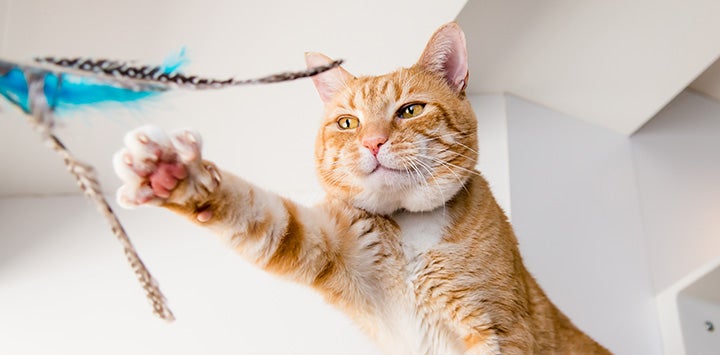
Feline Housing and Enrichment Training Playbook
Introduction
In almost every shelter across the country, cats make up a large part of annual animal intake. Unfortunately, they also comprise the majority of animals who lose their lives in shelters. Here, we discuss cats who are kept in your care for a short period of time (while waiting to be returned to the field) and those whose stay will be longer (while awaiting adoption, transfer or return to their owner). This playbook is designed to show the critical need to include a formal feline enrichment and housing program in your shelter’s daily operations and to provide resources on how to get started immediately.
Program Overview
The first 24 hours is the most critical time for a cat in a shelter. During this time, the staff’s ability to make the cat feel safe and secure can set the cat up for success in moving toward a positive outcome. Implementing a proper enrichment and housing program has been proven to reduce stress in cats, thereby reducing disease and injury to staff, and also making the cats more apt to be candidates for adoption.
Cats rely on a sense of familiarity to feel safe and secure. Unfortunately, when cats enter a shelter, they lose all that is familiar and are usually placed in small cages with unfamiliar sights, sounds and smells. This is often unavoidable in shelters, but the impact on the cats can be reduced with an effective enrichment and housing program.
Ideally, time would be allocated each day to provide enrichment for each cat. Enrichment can be done once cleaning has been completed; in some cases, it can even be done during cleaning. The type of housing amenities provided and the cleaning process itself are vital parts of the program. Here are some examples of ways to mitigate the cats’ stress:
- Staff should know when to spot-clean a cage and when it’s necessary to do a deep clean.
- When staff are cleaning cat areas, they are often rushed, moving around quickly and loudly closing the cage doors. It can be extremely stressful for the cats, so if staff are made aware, they can be a bit more sensitive to the cats’ needs.
- Having portals in the cages gives cats the freedom to go from one side to the other while cleaning is happening.
- Cats feel more comfortable when they are above their living space looking down, so putting a feral den or something similar in cages helps them to get elevated. In cases when a cat poses a risk to staff, a feral den can reduce the risk and provide a safe place for the cat to hide.
- Simply leaving items like blankets and toys (unless they need to be deep-cleaned) in the cage day after day builds up that sense of familiarity.
- Incorporating “aromatherapy” (spraying different scents in the cats’ room at different times of the day) and soothing sounds (playing calm music) are forms of enrichment that require little to no effort from staff. Use discretion when selecting scents for “aromatherapy” as some products can be harmful to cats.
In the resources below, you will find many other low-cost enrichment and housing ideas for cats in shelters.
Finally, get your volunteers and supporters on board. Volunteers are an invaluable resource to a program like this. Many shelters have organized teams of volunteers whose sole duty is to come in and interact with the cats. Sending out pleas to the community for donations of cat toys through social media and Amazon wish lists often results in an abundance of supplies and gives the community the opportunity to help in your efforts to save cats’ lives. One shelter even requested pine cones from the community. Pine cones offer a new scent and make great toys for cats to bat around.
Program Composition
When you’re setting up and implementing a successful cat enrichment program at your organization, we recommend that you have the following:
- Staff dedicated to cat enrichment
- A small cabinet or shelving unit to store the supplies
- A variety of cat toys
- Cans of air freshener of different scents
- Volunteer team dedicated to cat enrichment (optional but ideal)
- Amazon wish list
- Staff and volunteer training on cat enrichment
Sample Procedure and Program Information Documents
Now that you have a general understanding of a cat housing and enrichment program, the following documents may act as templates as you implement or scale up this program at your organization. Keep in mind that there is no exact or perfect form of implementation. Using the considerations and program composition notes above, you should use the following only as guidelines or building blocks when creating your own standard operating procedures or documents (both internal and public).
If you need further assistance or clarification, please reach out to your regional strategist, regional director or the Best Friends national shelter support team at team2025@bestfriends.org.
- Humane Animal Control manual, Cat Enrichment
- ASPCA Pro on cat hiding places
- Maddie’s Fund on cat enrichment
- UC Davis Koret Shelter Medicine Program on cat portals
- ASPCA Pro on spot cleaning
- ASPCA Pro on deep cleaning
- Template for cat enrichment board
- Template for cat enrichment log
- Consider applying for the Jackson Galaxy Cat Pawsitive program here
Updated May 2022
If you found this playbook helpful, check out our full catalog of handbooks, manuals, and playbooks.